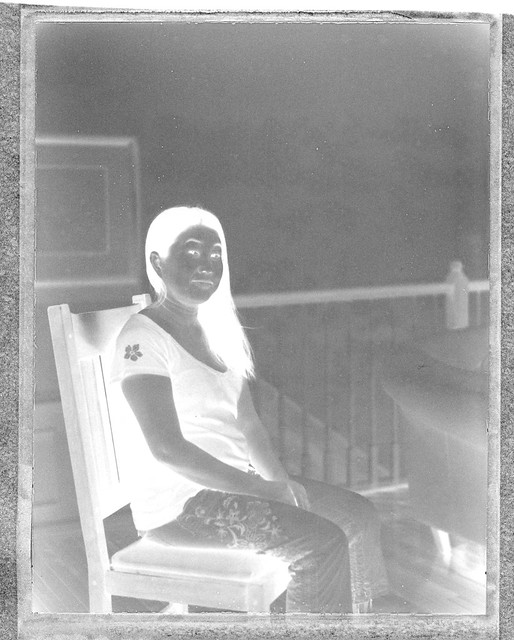My very good friend Dennis recently sold me his Mamiya Universal kit. Initially, I was not interested, as the Universal is an enormous and heavy medium format kit. More on that later. I'll post some images of the kit and why I now really find that I like it.
Well, one of the things that came with the kit was a Polaroid back. Unfortunately, it is designed for Polaroid 80 series film, which is no longer available. About a week of trolling ebay yielded a very nice replacement, which allows use of Fuji pack film. Currently there are two film options in this format - color at iso 100, and black and white (FP3000B) at iso 3000. How's that for a range?
Unfortunately, the FP3000B film has been discontinued. There are still stocks of it around, but at 2.5-3X the original cost. I have a few packs, but probably won't be able to buy more.
Here's a shot of my wife, made with the Universal, 150mm f5.6 lens, and FP3000B:
Scanned from Print
I was quite pleased when I saw this appear as I peeled the backing paper away. It's quite interesting to get a really sharp image with great optics on instant film. My old Polaroid camera just doesn't stand comparison.
Both types of pack film produce negatives in the process, but of very different types. The 100 speed color film negatives must be removed from the backing and bleached, producing a transparent negative. FP3000B produces a paper negative, which you simply have to protect and allow to dry in the dark (or near dark). Here's what the negative from the print above looks like:
Paper Negative, Fuji FP3000B Instant Pack Film
If you take the dry negative and scan it on a flatbed scanner (I use an Epson V750), you get something like the image above. Invert the tones and flip the image horizontally in Photoshop, and you get this:
Positive from Scanned Negative
Pretty cool, huh? The scan from the negative is sharper than the original print, but also shows grain. I love the slightly uncontrollable factors like the edge patterns and occasional black dots. This feels like real photography to me.
One note - you'll notice lens vignetting on instant prints from the Mamiya Universal. It's designed for maximum size images of 6x9 on 120 film. The pack film image is larger than that. Reportedly, the Mamiya 75mm and 127mm lenses don't vignette on pack film. I don't have either, so can't say for sure.
Having shot a few rolls of film in the Universal, I'm anxiously awaiting an email from The Darkroom, notifying me that the film I sent in last week is processed and scans are posted. Based on the instant results, I'm expecting some amazing image quality from the normal medium format film I've shot.
More to come from the Mamiya Universal!
DMC-365.blogspot.com
Need great film processing? (Click Here) to visit The Darkroom. They're the best in the business.



No comments:
Post a Comment